These 7 most hunted animal are now on the verge of extinction
On one side, the world is trying to save endangered species; on the other side, there are people who are ruthlessly hunting animals for the sake of money and fun. Rare animals, as well as their parts, sell at a high price on the black market, encouraging more people towards poaching. According to petpedia, approximately 30,000 species are forced into extinction every year. Here are some of the most hunted animal s that are on the verge of extinction.
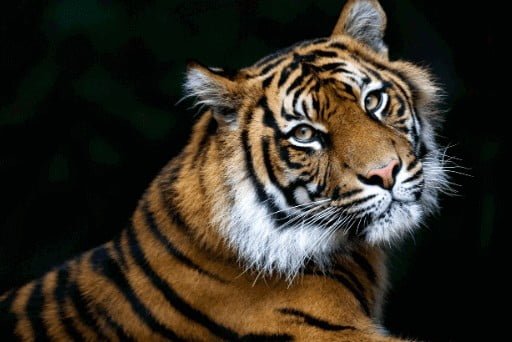
#1 Tigers
Tigers have become highly valuable commodities in the black market due to their enormous demand, leading to exorbitant prices. Tragically, tigers are being mercilessly hunted and killed worldwide, primarily for their bones and pelts. The bones are in high demand in China, where they are used to produce Tiger bone wine, a luxurious traditional Chinese medicine tonic believed to possess the strength and vitality of the Tiger.
The skin of tigers is another prized resource, utilized in the creation of high-end luxury items. The demand for these products, such as rugs, clothing, and accessories, further fuels the illegal trade and poaching of tigers.
The World Wildlife Fund, has alarming statistics, indicating that there are only approximately 3,900 tigers remaining in the world. This decline in their population is mainly due to factors like habitat loss, poaching, and illicit trade. Urgent conservation efforts and strict enforcement of wildlife protection laws are crucial to addressing this critical situation.
In the United States, an interesting situation arises where more tiger species are held in captivity than in the wild. Some individuals and private facilities keep tigers as exotic pets or for entertainment purposes. While captive populations can play a role in conservation efforts, it is essential to establish and enforce regulations to prevent illegal trade and ensure the well-being of these magnificent creatures.
Preserving tigers and their habitats is a pressing global concern. Collaborative efforts by international organizations, governments, and conservationists are underway to combat poaching, enhance anti-trafficking measures, protect vital tiger habitats, and raise awareness about the importance of safeguarding this iconic species. The ultimate goal is to secure a future where tigers can thrive in the wild, free from the threat of human greed and exploitation.
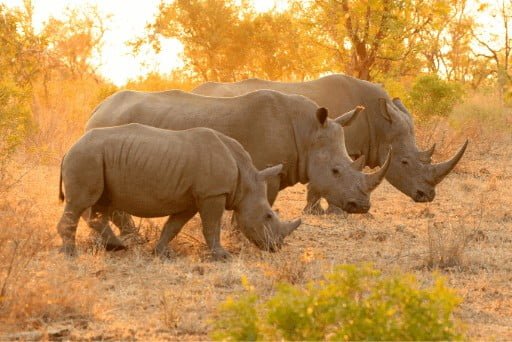
#2 Rhinoceros
In the wild, adult rhinos face no natural predators apart from humans, yet they are critically endangered due to extensive hunting. They are among the most hunted animals in the world, primarily for their valuable horns. The demand for rhino horns is particularly high in Asia, where they are used in traditional medicine and ornamental cravings. These horns are believed to possess curative properties for conditions such as impotence, cancer, and hangovers.
It is important to note that rhino horns are composed of Keratin, the same material found in our nails and hair, and have no scientifically proven medicinal benefits. However, the persistent belief in their healing properties continues to drive the illegal trade and poaching of these magnificent creatures. In addition to rampant hunting, habitat destruction poses a significant threat to rhino populations. As the human population continues to grow, urbanization, road construction, agricultural expansion, and logging activities lead to the destruction and fragmentation of rhino habitats.
According to data from 2020, there are approximately 27,000 rhinos remaining in the wild. This number is drastically reduced compared to the 70,000 rhinos that existed in 1970. The declining population is a grave concern that necessitates urgent conservation efforts and stringent measures to combat poaching, eliminate illegal trade, protect their habitats, and raise awareness about the importance of preserving these iconic creatures.

#3 Elephants
Elephants, among the largest mammals on Earth, possess complex consciousness and thinking abilities. Elephants also exhibit a remarkable understanding of emotions and display strong familial bonds. However, these magnificent creatures face the daily threat of hunting and are among the most targeted animals by poachers. The primary driver behind elephant poaching is the demand for their ivory.
Despite international bans on the ivory trade, elephants continue to be poached in significant numbers. The ivory tusks of elephants are highly valued and sought after for various purposes, such as the production of jewelry, ornaments, piano keys, and billiard balls. These products contribute to the ongoing illegal trade and exploitation of elephants.
In addition to ivory, elephants are also hunted for their skin and meat, especially in the case of Asian elephants. These practices further compound the threats faced by these animals. The illegal killing of elephants for their valuable body parts poses a grave risk to their survival and conservation.
As of 2020, the global population of elephants stands at approximately 415,000 individuals. This number represents a significant decline from historical populations due to rampant poaching and habitat loss. The need for immediate and concerted action to protect and conserve these magnificent creatures is evident.
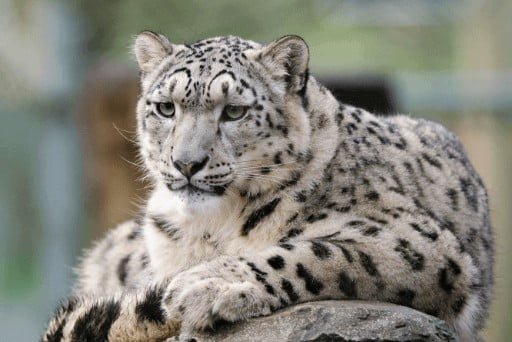
#4 Snow Leopards
Snow leopards are facing a severe struggle for survival due to extensive poaching activities. These majestic creatures often fall victim to poachers, particularly in remote mountainous regions where they inhabit. Furthermore, snow leopards are sometimes killed by farmers in retaliation for preying on their livestock, which includes yak calves, horses, goats, and sheep. While snow leopards primarily hunt wild prey such as Argali sheep, these same prey species are also targeted by local hunters.
As a result, snow leopards are increasingly forced to turn to livestock as a food source as their natural prey becomes scarce. This creates conflicts between the snow leopards and local communities who depend on their livestock for sustenance and livelihoods. The escalating human settlement and expansion of grazing areas further exacerbate the challenges faced by these elusive felines.
According to the World Wildlife Fund (WWF), the global snow leopard population is estimated to be around 4,000 individuals. This number is alarmingly low and highlights the urgent need for conservation efforts to protect and restore their habitats, mitigate human-wildlife conflicts, and combat illegal poaching.
Conservation organizations, governments, and local communities are working together to implement measures aimed at safeguarding snow leopards. These initiatives include the establishment of protected areas, the promotion of sustainable livestock practices, and community-based conservation programs that involve local communities in the conservation efforts.
Preserving the snow leopard population is crucial not only for their own survival but also for the overall health and balance of their mountain ecosystems. By addressing the underlying causes of decline, raising awareness, and fostering sustainable coexistence between humans and snow leopards, we can strive to secure a future where these magnificent creatures can continue to roam the snowy peaks of their natural habitats.
.
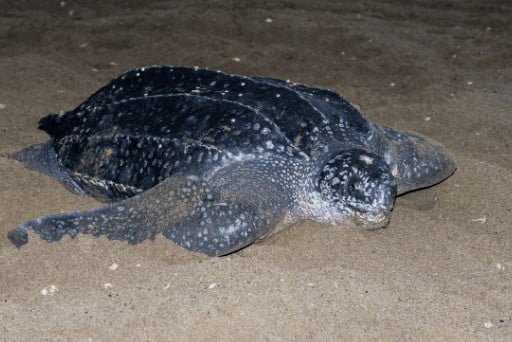
#5 Leatherback Sea Turtles
Leatherback Sea Turtles, the largest turtles in the world, have existed since the era of dinosaurs. These remarkable creatures possess remarkable migratory abilities, with some individuals traveling over 10,000 miles in a single year. However, the present-day reality for leatherback sea turtles involves numerous threats both in the ocean and on nesting beaches.
One of the most significant dangers they face is becoming entangled in fishing gear. The incidental capture of these turtles in fishing nets and lines poses a severe threat to their survival. Additionally, leatherback sea turtles are hunted and their eggs collected for consumption. In certain regions, particularly in Asia, these turtles are targeted for their flesh and oil, while their eggs are harvested for food.
The global population of leatherback sea turtles currently ranges between 20,000 and 30,000 individuals. This relatively low number underscores the urgent need for conservation efforts to protect these ancient creatures and prevent their extinction.
Efforts to mitigate the threats faced by leatherback sea turtles involve various strategies. Conservation organizations and governments work to implement measures to reduce bycatch in fishing gear, like the use of turtle-friendly fishing practices. Campaigns and initiatives aim to raise awareness about the importance of protecting nesting beaches and the prohibition of egg collection.
By addressing the threats they face and implementing sustainable practices, we can strive to safeguard the future of the Leatherback Sea Turtles. Their continued existence not only holds ecological significance but also serves as a reminder of the rich biodiversity that our planet has nurtured for millions of years.

#6 Gorilla
Gorillas are facing a severe threat to their survival due to rampant poaching, which has led to their endangered status. Despite significant awareness efforts, hunting remains the primary cause of their decline. Today there are 1063 mountain gorillas left, and they are seen in DRC, Rwanda, and Uganda.
One of the primary motivations behind the killing of gorillas is their meat. While some African communities traditionally consume gorilla meat, it is also sought after for sale to other nations, as it presents a lucrative source of revenue for poachers and illegal traders. This illegal trade further exacerbates the pressure on gorilla populations.
Additionally, certain body parts of gorillas are erroneously believed to possess medicinal properties, although there is no scientific evidence to support these claims. This misconception drives the demand for gorilla parts in certain markets, contributing to the illegal trade and poaching.
The dwindling population of gorillas highlights the urgent need for conservation measures to protect these iconic primates. Efforts such as anti-poaching initiatives, community engagement, and habitat preservation are crucial for their survival. Collaboration is needed to combat poaching and enforce wildlife protection. Preserving gorillas ensures their existence and supports ecosystem biodiversity.
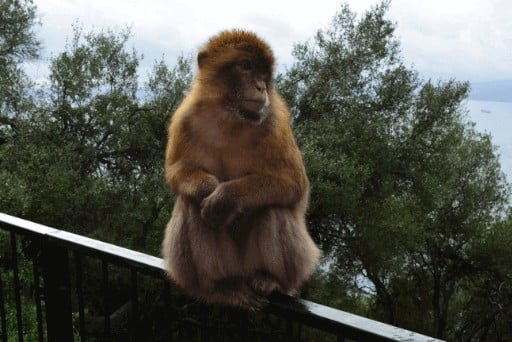
#7 The Barbary Macaque
These creatures are found in the Atlas Mountains and Northern Sahara. Over the last 24 years, the population of The Barbary Macaque has witnessed a decline of more than 50%. Fragmentation and habitat loss are considered the primary threats to the existence of these species. They are also hunted to be taken as pets or removed from their natural habitat. Presently, their population stands around 6,500 to 9100.
Final Thoughts
Animals are important to complete nature’s cycle, but humans continue to live in ignorance. Although a lot has been done to protect endangered species, these most hunted animal s continue to be poached for personal gains.
FAQs about Most Hunted Animal
Why are certain animals hunted and what is the impact on their populations?
Certain animals are hunted for various reasons, such as their valuable body parts, meat, or perceived medicinal properties. This relentless hunting has a devastating impact on their populations, pushing them toward endangerment or extinction.
How does the illegal wildlife trade contribute to the hunting of endangered species?
Illegal wildlife trade fuels the hunting of endangered species by creating a lucrative market for their parts and products. The high demand for these items encourages poachers to target and kill these animals, driving their populations to decline rapidly.
Are there any regulations in place to protect these hunted animals?
Yes, there are international and national regulations aimed at protecting endangered species and preventing their hunting. However, enforcement of these regulations can be challenging, and illegal activities continue to persist due to the allure of profits from the black market trade.
What are the consequences of hunting these animal?
The consequences of hunting these animals are dire. It disrupts ecosystems, leading to imbalances in natural populations. Additionally, the loss of these species can have cascading effects on the overall biodiversity and ecological stability of the habitats they inhabit.
How can individuals contribute to the conservation of these hunted animals?
Individuals can contribute to the conservation of hunted animals by supporting organizations working to combat wildlife poaching, raising awareness about the consequences of illegal hunting, and advocating for stronger enforcement of wildlife protection laws. Choosing not to participate in the purchase or trade of products derived from endangered species is also crucial.
Are there any alternative livelihood options for communities engaged in hunting?
Efforts are being made to provide alternative livelihood options for communities engaged in hunting. These include promoting sustainable tourism, supporting eco-friendly enterprises, and providing education and training opportunities that help communities benefit from conserving wildlife rather than exploiting it.




